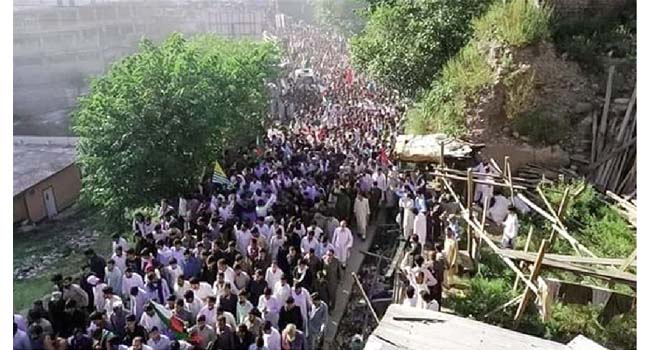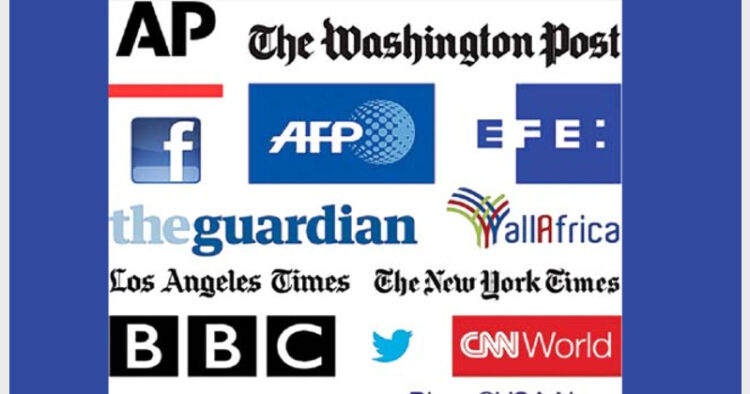
The reporting on the amendment to Article 370 and removal of 35A in the foreign media grossly ignores the plight of women and minority Hindus in Kashmir Valley
Anugula Rakesh Reddy
Recently, the Government of India paved the way for the long-pending complete integration of Jammu & Kashmir (J&K) into the Republic of India. While the move was regarded as an internal affair of India, with celebrations all over the country, some of the American media reactions have been rather dismissive. A quick look at the reportage shows a starc bias against religious minorities and women of Jammu & Kashmir (see table on next page for detail). 
The State of J&K (now bifurcated into two Union Territories was a Muslim majority state, with the Hindus, Sikhs and Buddhists as the main religious minorities. Within the state, while the region of Kashmir is dominated by Muslims, whereas Jammu and Ladakh are not. Historically, the region was mostly inhabited by indigenous Dharmic faiths of India i.e. Hinduism, Buddhism, Jainism and Sikhism.
Kashmir has been named after the Rig Vedic (1500 BCE) philosopher Kashyap Muni who is said to have settled there. Alexander of Macedon recorded King Abhisara ruling the region. Under Emperor Ashoka, both Buddhism and Shaivism branches of the Hinduism flourished with several shrines built there. Several Hindu and Buddhist rulers administered the region, including the Lohara dynasty, which repelled the Islamic invader Mahmud of Ghazni, who destroyed several temples elsewhere in the subcontinent, including the Somnath Temple in Gujarat. Islamic rule of the region is a relatively recent phenomenon, which started in the 14th century AD and continued under the Mughal and Afghan invaders. In the 19th century, Sikh King Ranjit Singh recaptured Kashmir and finally became a princely state of the British Empire with the Dogra Dynasty ruling the region.

No News for International Media: Thousands of people at
Mirpur- Muzaffarabad area of Pakistan occupied Jammu & Kashmir are in the streets against illegal occupation of the region by Pakistan. But it finds no mention in the international media
Mirpur- Muzaffarabad area of Pakistan occupied Jammu & Kashmir are in the streets against illegal occupation of the region by Pakistan. But it finds no mention in the international media
Both secular India and Islamic Pakistan became independent nations in August 1947, while the erstwhile Princely State of J&K did not join either. However, just two months later, Pakistan-backed raiders invaded the kingdom, with the aim of ethnically cleansing the minorities and merging it with the Islamic Republic of Pakistan. Pakistani forces made rapid gains capturing the city of Mirpur. Hindu women were abducted and sold into brothels of Rawalpindi. Over 400 women committed suicide to escape the raiders. At that time Maharaja Hari Singh of J&K signed the Instrument of Accession to the Republic of India. India then rushed troops to defend J&K. A ceasefire was reached based on United Nations Resolution 47, which recommended a 3-step process for the resolution of the conflict, starting with Pakistan requiring to withdraw all its invaders from J&K. However, with Pakistan’s unwillingness to demobilise its forces, especially its ‘Azad Kashmir’ forces (consisting of 60,000 Pakistani WW2 veterans with “Allah hu Akbar” as their motto), led to the Indian side stopping its withdrawal. Thus, the resolution fell through leading to a stalemate.
In the 1950s, the State of J&K was accorded special status under temporary Article 370 of the Indian Constitution. It allowed J&K to have its own Constitution and pass its own laws. In the 1980s, Pakistan’s Inter-Services Intelligence (ISI) cooperated with the USA’s Central Intelligence Agency (CIA) to train and supply irregulars to fight the Soviets in Afghanistan. ISI used the experience gained to mount a similar strategy against India. Pakistan-backed Islamic terrorist groups began the process of ethnically cleansing Kashmiri Hindus with the aim of altering the demographics of the region and establishing Islamic rule. Neither the J&K Government nor the Home Minister of India (akin to the US Secretary of State) Mufti Mohammad Sayeed (a Kashmiri politician himself) did anything significant to stop the exodus. Of over 500,000 Kashmiri Pandits in 1990, most fled their historical lands, with only 3000 or so remaining by 2016. Massacres by Kashmiri terrorists were also directed against Sikhs in Kashmir Valley, such as when 35 Skikhs were lined up outside their Gurudwara and shot. Over 62,000 families are registered as internal refugees, with many still living in dire poverty.
Women of J&K too were suppressed with sexist provisions enshrined in Article 35A, which allowed J&K to discriminate Indian citizens from other states, by not allowing them to become permanent residents, nor acquire property nor jobs. This act stripped only women of their residency rights if they married someone from a different state. This law is reminiscent of Sharia-inspired laws of several Middle Eastern Islamic nations that revoke a woman’s citizenship if she marries a foreigner, but not a man’s. Notwithstanding changes made to this unfair law in 2004, it was challenged again in the Supreme Court in 2015, on grounds that the law discriminated against women’s heirs by denying them residency rights and also discriminated against the lower caste settlers by denying them Constitutionally-guaranteed affirmative action benefits.
Any balanced discussion on this sensitive issue must take into account the above points, by at least referencing them at a bare minimum. Some of the foreign media articles blatantly ignore or misrepresent the narrative of J&K’s minorities and women.
(The writer is an economist and director of Center for Leadership and Governance)













Comments